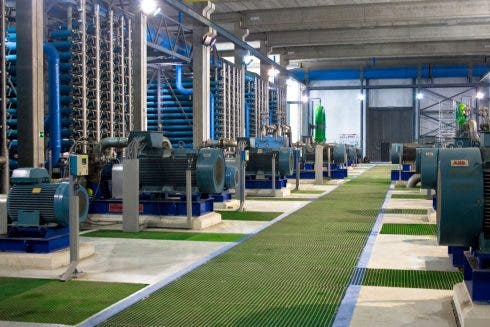AS water woes grow in Spain and elsewhere, experts have pointed to desalination — the process of making seawater drinkable — as a possible solution to water scarcity.
There are currently 770 desalination plants operating in Spain and more are expected to be built soon.
Australia was the first country to employ large-scale desalination.
Nowadays, arid countries use it widely to address water needs, with Saudi Arabia being the world’s top desalinator.
In 2019 there were 16,000 desalination plants spread throughout 177 countries worldwide, producing some 95 million cubic metres of water per day.
There’s a growing global need for desalination as temperatures climb and droughts ravage reservoirs.
The number of desalination plants worldwide has since increased to 21,000 in 2022, nearly doubling in quantity since 2012.

Estimates have put the number of people who live in regions where water is scarce at 1.5 billion or more, a number that is only increasing.
Spain is the world’s fifth largest producer of desalinated water, with 770 large-scale desalination plants, 99 of which are high capacity, meaning they produce between 10,000 and 250,000 cubic metres of water per day.
A large portion of these plants are located in the Canary Islands, where limited fresh water sources have led to a dependence on desalination.
Currently, Spain holds the title for having the largest desalination plant in Europe made for human consumption, the El Prat plant in Catalunya, which provides water to 4.5 million people and produces 60 million cubic metres per year.
In February, Catalan ministers Teresa Ribera and David Mascort announced that they’d secured €467 million in funding from the Spanish government to finance two new desalination projects in the region, where a historic drought has put reservoirs at 16% capacity and led to strict water use restrictions.
A press release states that €267 million will go directly to the construction of a new desalination plant near the town of Blanes, next to the Tordera I plant, which was inaugurated in 2002 and was Catalonia’s first desalination plant.
The new facility is scheduled to open in 2028, and will produce some 60 million cubic metres of water each year.
And as part of Andalucia’s “Drought Plus” program, announced by the Junta in December, the community’s government will begin installing “portable” desalination plants in Marbella, Axarquía and other water-stressed municipalities, and will also prep Andalucian ports to receive desalinated water via ship from other autonomous communities.
How does desalination work?
The process happens naturally during the Earth’s water cycle.
Seawater evaporates, leaving salt and minerals behind, then forms clouds before falling back to Earth as rain.
Most commonly, desalination plants utilise what’s called reverse osmosis.
Seawater passes through specialised membranes that trap the salt, leaving behind freshwater.
Another process involves the evaporation of seawater using heat from the sun.
In this process, which requires ample space, the evaporated seawater, now salt-free, is collected in the roofs of large facilities.
Other techniques involve electrodialysis, which uses charged membranes to trap the salt ions; nanofiltration, which utilises highly permeable nanomembranes, allowing the more efficient production of freshwater than reverse osmosis; and gas hydrates, which involves the combination of seawater with solid crystals at high pressure, causing the salt to disappear.
However, one of the drawbacks of desalination is the large amount of waste it can produce.
According to a January 2024 report by the United Nations University’s Institute for Water, Environment and Health, 1.5 litres of salty brine are produced for every litre of freshwater through desalination.
Most of the world’s desalination plants are near the coast, with some 80% of the world’s desalination brine produced within 10 kilometres of the ocean.
The report estimates that global desalination plants discharge 142 million cubic metres of waste brine each day, most of which comes from desalination plants in Saudi Arabia, the UAE, Kuwait, and Qatar.
READ MORE
- Drought decree latest: Marbella desalination plant set to quadruple its capacity as recent rains partially replenish Andalucia’s reservoir levels
- Estepona to build desalination plant after recent storms fail to halt dwindling water supplies








